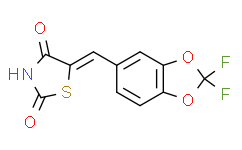| Cas No.: | 648449-76-7 |
| Chemical Name: | (5E)-5-[(2,2-Difluoro-1,3-benzodioxol-5-YL)methylene]-1,3-thiazolidine-2,4-dione |
| Synonyms: | AS-604850;PI 3-Kinase Inhibitor (AS604850) B-0302;5-(2,2-Difluoro-benzo[1,3]dioxol-5-ylmethylene)-thiazolidine-2,4-dione;PI3Kγ inhibitor;PI 3-Kgamma Inhibitor II;(5E)-5-[(2,2-DIFLUORO-1,3-BENZODIOXOL-5-YL)METHYLENE]-1,3-THIAZOLIDINE-2,4-DIONE;PI3Kgamma inhibitor;(5Z)-5-[(2,2-difluoro-1,3-benzodioxol-5-yl)methylidene]-1,3-thiazolidine-2,4-dione;BYM;2a4z;AS604850;PI 3-Kg inhibitor II;MLS006010996;GTPL6024;HMS3261F11;HMS3229I21;HMS3650F11;BCPP000389;Tox21_500505;s2681 |
| SMILES: | S1C(N([H])C(/C/1=C(\[H])/C1C([H])=C([H])C2=C(C=1[H])OC(O2)(F)F)=O)=O |
| Formula: | C11H5F2NO4S |
| M.Wt: | 285.2235 |
| Purity: | >98% |
| Sotrage: | 2 years -20°C Powder, 2 weeks 4°C in DMSO, 6 months -80°C in DMSO |
| Description: | AS-604850 is a potent, selective and ATP-competitive PI3Kγ inhibitor with an IC50 value of 0.25 μM and a Ki value of 0.18 μM. AS-604850 shows isoform selective inhibitor of PI3Kγ with over 30-fold selectivity for PI3Kδ and β, and 18-fold selectivity over PI3Kα, respectively[1]. |
| In Vivo: | AS-604850 (10-100 mg/kg; oral administration; for 4.5 or 4.25 hours; Balb/C or C3H mice) treatment reduces RANTES-induced peritoneal neutrophil recruitment with an ED50 value of 42.4 mg/kg. In the thioglycollate-induced peritonitis model, oral administration of 10 mg/kg AS-604850 results in a 31% reduction of neutrophil recruitment[1]. Animal Model: Balb/C or C3H mice with human recombinant RANTES or thioglycollate[1] Dosage: 10 mg/kg, 30 mg/kg or 100 mg/kg Administration: Oral administration; for 4.5 or 4.25 hours Result: Reduced RANTES-induced peritoneal neutrophil recruitment with an ED50 value of 42.4 mg/kg. In the thioglycollate-induced peritonitis model, resulted in a 31% reduction of neutrophil recruitment. |
| In Vitro: | AS-604850 inhibits C5a-mediated PKB phosphorylation with an IC50 of 10 μM in RAW264 mouse macrophages[1]. AS-604850 blocks PKB phosphorylation induced by MCP-1 and has little or no effect after stimulation with CSF-1 in in primary monocytes from Pik3cg+/+ or Pik3cg–/– mice[1]. AS-604850 (0-30 μM; 15 minutes; primary monocytes from Pik3cg+/+ mice) treatment inhibits MCP-1-mediated phosphorylation of PKB and its downstream substrates GSK3α andβ in a concentration-dependent manner. MCP-1-induced phosphorylation of p44/42 ERK (ERK1/2) MAPKs is also reduced, in a concentration dependent manner in primary monocytes from Pik3cg+/+ mice[1]. Western Blot Analysis[1] Cell Line: Primary monocytes from Pik3cg+/+ mice Concentration: 0 μM, 1 μM, 3 μM, 10 μM, 30 μM Incubation Time: 15 minutes Result: Inhibited MCP-1-mediated phosphorylation of PKB and its downstream substrates GSK3α andβ in a concentration-dependent manner. MCP-1-induced phosphorylation of p44/42 ERK (ERK1/2) MAPKs was also reduced, in a concentrationdependent manner in primary monocytes from Pik3cg+/+ mice. |
| References: | [1]. Camps M, et al. Blockade of PI3Kgamma suppresses joint inflammation and damage in mouse models of rheumatoid arthritis. Nat Med. 2005 Sep;11(9):936-43. |

 To enhance service speed and avoid tariff delays, we've opened a US warehouse. All US orders ship directly from our US facility.
To enhance service speed and avoid tariff delays, we've opened a US warehouse. All US orders ship directly from our US facility.




















